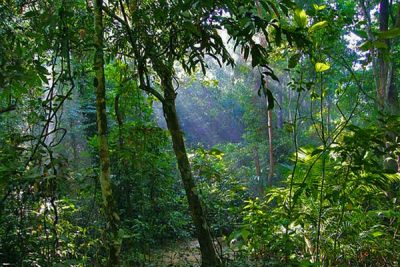By
Ali Sanwar
Passing a large cluster of mud houses with their big wild roses and cows, the transparent water of the small brook surprised us. This was Lawachara.
The hills, like all hills the world over, had absorbed water during the rains and generated this small stream. Due to the limited use of the spring,the water remained unpolluted and one could see through it.
Beyond the stream a small forest trail entered into the rubber plantation adjoining the forest, here, in Chautali.
Half a kilometer from the newly built road and in the rubber plantation, Chevron – the oil giant, is carrying out its seismic activity to determine the gas reserve in the MoulviBazaar gas field. The company feels that a better understanding of the gas field will allow it to pump out more gas to feed the national grid. But some of the work, 7 per cent, precisely, has to be carried out in the Lawachara reserve forest which has created some commotion in the nation’s media.
We passed several bamboo signs with an X mark on top of a mound of soil. These we were told are future sites for conducting seismic surveys. Each mound was approximately 10 meters apart. A little later, the mounds had small wires going out. On both sides were tall grasses and small trees with the inevitable cow munching on the vegetation. Behind the grass, stretched paddy fields that the locals were using.
The small sound of explosions, reverberating from the hills, sounded hollow and soft. As we came closer and entered the rubber plantation the sounds got louder. A couple of hundred meters through the rubber trees and we were at the epicenter of the underground blasts. As we stood a meter or so away from the seismic boom we felt the sound reverberate in a muffled way and the earth shook momentarily. The sound was calculated at 75 decibels.
The blast, at the head of a 70 meter tube well pipe, was nothing extraordinary, and as we looked around, there were no signs of dislocation. The incessant sound of thousands of crickets continued as they screeched away, as usual. Because of the mono crop rubber trees, there were not many other wildlife around. Throughout the trek, we had looked around for the hillock gibbons and the birds but there were hardly any.
Why should there be any? The land is either mono-cropped or shrubs. Rubber trees and tea gardens are all around, hardly the best of places for wildlife to survive. Later in the day, as we visited the Lawachara reserved forests, we saw a squirrel running away from one of the tall trees. It was characteristic of it and once again, as dusk fell, the sound of a million crickets was becoming deafening. A little further away, there was a small flock of hullock gibbons, jumping from tree to tree, till they perched on one of them, only to jump away again.
At the gates of Lawachara reserve forest we met the chairman of the forest preservation committee, a professor of a nearby college. We asked him what types of trees were there in the forest. He looked at one and said that it was a teak. But he went on to add, that all were not teak. There were other varieties, too. But all trees were of a commercial important variety, he proudly said. No wonder loggers and poachers have a field day. Many of the trees had a small sign stuck on them saying when they were planted. Most were planted in the last years of the British Raj. So much for the tropical rain forest and bio-diversity of the reserved forest.
Meanwhile, we dropped in at a village in the Ansar Camp area that hosted the 42nd Ansar Battalion. It was four or five kilometers from the seismic spot and one could not hear the sound of the seismic work anymore. Most houses there were typically mud built and had developed cracks. We asked the villagers the reason and they explained that because of the large presence of sand the mud walls cracked in summer. Houses that were built by sifting the sand were less crack-prone. The reconstruction was carried out when the rains came and the weather was a little cooler.
But problems persist as some local people feel that they have been left out of the process. But then, that is an endless process.
Chevron insists that the seismic survey will increase their production from the MoulviBazaar gas field by 50% and that more than 80% of their work has been completed. “One cannot leave out a certain portion of the gas field and make an assessment of it”, a company official explained. The company also insists that only 7% of their work is in the reserved forest and that they will not drill there.
IUCN (The World Conservation Union) has made an environmental impact assessment of the company’s proposed work site and their suggestions have been incorporated in the work plan, Chevron officials said. So far, there have been no reports of deviation from the work plan.



No Comments Yet!
You can be first to comment this post!